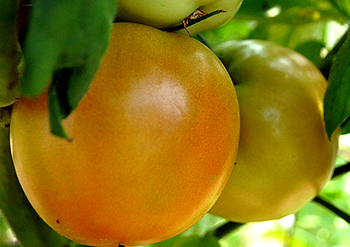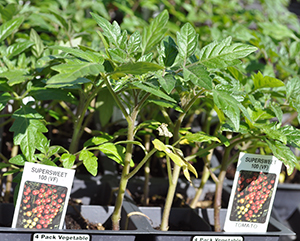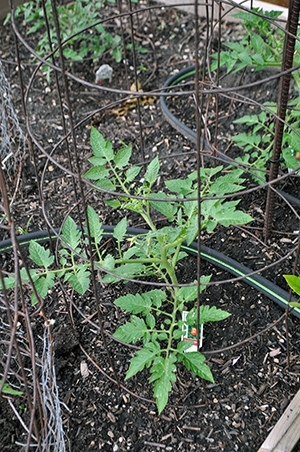How to Grow Your Own Tomatoes
Return to Vegetables Agent Articles
 Home grown tomatoes are the number one backyard vegetable grown. Everyone knows the flavor of a tomato picked fresh from the vine can never compare to those found on supermarket shelves. Commercially grown tomatoes have the texture of Styrofoam and the flavor to match. Those picked at home simply melt in your mouth with flavor.
Home grown tomatoes are the number one backyard vegetable grown. Everyone knows the flavor of a tomato picked fresh from the vine can never compare to those found on supermarket shelves. Commercially grown tomatoes have the texture of Styrofoam and the flavor to match. Those picked at home simply melt in your mouth with flavor.
Tomatoes are fairly simple to grow here in Kansas City. With an investment of a few dollars you can savor the joy of picking your own red ripe fruits fresh off the vine. While tomatoes are simple there are a few tips that can increase your success.
Location is key
Success with tomatoes means finding the right spot in the garden. Tomatoes require at least six hours of bright sunlight each day. This can be a limiting factor for some would-be gardeners when mature trees dot the landscape. Low-light levels do not allow for the plant to thrive, flower and produce loads of red ripe fruit.
Plant in mid-May
Tomatoes are a warm-season crop. This means they do not tolerate cool spring air and soil temperatures. Tomatoes will be killed by a late-spring frost. Mid-May is the ideal planting date in the Kansas City area. By that time the chance of a frost has passed and the air and soils have warmed to support growth. Plants set out earlier are stressed by cool conditions. Tomatoes can be planted much later, even into June but the harvest will be delayed.
 Choose short, stocky transplants
Choose short, stocky transplants
Tomatoes are best planted from a transplant instead of seeds. Transplants can be found at any garden center. Selecting a healthy transplant is important. A healthy transplant should be short and stocky with a fresh green color. The ideal transplant would be about six inches tall with a thick bulky stem and the foliage would look healthy, free from blemishes or a purple undertone. Avoid transplants that are tall, leggy and tend to flop. This indicates the plant is over-grown or has been mishandled. Starting with healthy vigorous transplants ensures success.
Planting tomatoes outside
Everyone seems to have their own trick for planting. Talk with fellow gardeners and they will mention to plant it deep or lay it on its side. I will admit there are disagreements in the gardening world which method is best. My recommendation is if you purchase a quality transplant then there is no need to plant deeply or lay it on its side.
Before planting knock the plant out of its growing container. Even if it is grown in a natural biodegradable container removal is still best. Once the roots are exposed there should be a white mass of healthy roots. If these roots are compacted and spiraling it is recommended to use your fingers to tease apart the roots. This allows the roots to grow out into the garden soil instead of remain girdled from vigorous growth.
The short stocky transplant is planted at the same soil level it was growing in the container. If you fall prey to overgrown plants then you may want to lay the plant on its side and cover up the excess stem to help reduce it from being whipped around with the wind. Some tomato gardeners like to lay the plant on its side and bury part of the stem as the plant will develop roots along the stem. They feel this promotes better growth. Be cautious not to bury the foliage as the leaves are needed to make energy for the developing plant.
Watering and fertilizing tomato plants
All garden transplants should be thoroughly watered into the soil. The use of a diluted fertilizer at this time may help increase establishment by providing a little boost for the growing roots. The simplest transplant solution may be one of the water soluble fertilizers already setting on your shelf.
Tomatoes are not big feeders. Sprinkling a tablespoon or two of fertilizer around the planting prior to planting is probably all they will need to produce a good crop.
Tomatoes, while well adapted to our summer conditions will grow best with an even supply of moisture. Uneven moisture will result in lower fruit set and quality. Help prevent diseases by watering around the base of the plant, avoiding wetting the foliage. Mulching with leaves or straw will help conserve moisture and keep the soil cooler, which means bigger yields.
Plant and wait
Once planted it becomes a waiting game. The plant will continue to grow and eventually set flower buds. Tomatoes are wind pollinated. Small fruits will develop and the hope is that your first vine ripe tomato will be ready for harvest around the fourth of July. The best harvest is usually mid-July through mid-August. But with good care tomato harvest can last into the fall, only to stop with the first frost of the season.
Variety selection is often a personal choice. Basically tomatoes fall into two categories;
- hybrid and
- heirloom varieties.
Each type has their benefits and disadvantages. Hybrid varieties tend to be heavier producers and the vines less rangy. Heirloom varieties will have better flavor on larger vines. Hybrid tomatoes are resistant to many common soil borne diseases. Heirlooms have little built-in resistance.
Unfortunately, neither type has good resistance to the most common problems, foliar diseases. Septoria leaf spot and early blight are windblown diseases that cause the lower foliage to yellow and wither. As the disease progresses it moves up the plant reducing its ability to manufacture energy and yields decline. Fungicide treatments are available but must be applied repeatedly. Organic controls are limited. Good cultural practices that include sanitation, air movement and the avoidance of wet foliage are the best options.
 Staking or caging tomatoes
Staking or caging tomatoes
One way to help reduce the spread of disease is to cage or stake the tomato plants. Caging gets the plant up off the ground increasing airflow allowing the plants to dry more rapidly, keeping the disease in check. Caging makes harvest easier as the developing fruits can easily be seen.
Caging tomatoes requires a heavy duty structure that will support the weight of the vine without falling over. Cylinder wire tomato cages can be purchased. Honestly, while they look like they will do the trick pre-made cages rarely provide the support. Most are constructed from lightweight wire and are too short to support the growth. The result is the entire wire cage flops to the ground in mid-summer leaving a sprawling mess of vines.
The best tomato cages are homemade from concrete reinforcing wire found at hardware stores. This heavy duty wire comes in heights up to five feet. Cut the wire into lengths of five to six feet. Then form a circle and secure. This will create a tomato cage around eighteen to twenty-four inches in diameter, perfect for most backyard gardens. A T-post will be needed to hold the cage upright against our Kansas City winds. Whether you are a seasoned grower or this is your first time, tomatoes are an easy crop to grow in backyard gardens. Tomatoes are fairly low-maintenance but with a little care they will produce loads of fresh and tasty fruit. Just thinking about tomatoes makes my mouth water for a slice, or better yet a BLT.
Whether you are a seasoned grower or this is your first time, tomatoes are an easy crop to grow in backyard gardens. Tomatoes are fairly low-maintenance but with a little care they will produce loads of fresh and tasty fruit. Just thinking about tomatoes makes my mouth water for a slice, or better yet a BLT.
by Dennis Patton, Horticulture Agent, 2022
Have questions? The Garden Hotline is staffed by trained EMG volunteers and Extension staff who will assist you with questions.
Phone: (913) 715-7050
Email: garden.help@jocogov.org